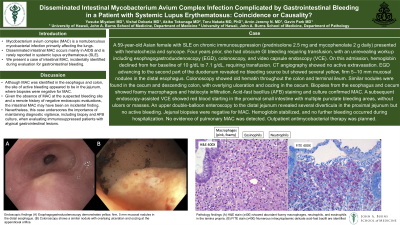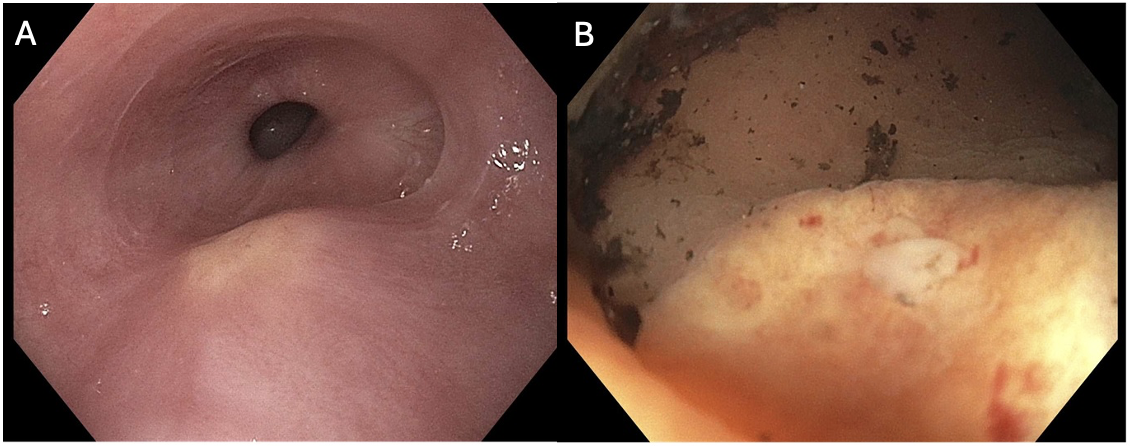Tuesday Poster Session
Category: GI Bleeding
P5230 - Disseminated Intestinal Mycobacterium avium Complex Infection Complicated by Gastrointestinal Bleeding in a Patient With Systemic Lupus Erythematosus: Coincidence or Causality?
Tuesday, October 28, 2025
10:30 AM - 4:00 PM PDT
Location: Exhibit Hall

Has Audio

Yusuke Miyatani, MD
University of Hawaii, John A. Burns School of Medicine, Department of Medicine
Honolulu, HI
Presenting Author(s)
Yusuke Miyatani, MD1, Vishal Dobaria, MD1, Akiko Tokunaga, MD2, Toru Nakata, MD, PhD1, Arvin Jeremy N. Tan, MD1, Gavin Park, MD3
1University of Hawaii, John A. Burns School of Medicine, Department of Medicine, Honolulu, HI; 2University of Hawaii, John A. Burns School of Medicine, Department of Pathology, Honolulu, HI; 3University of Hawaii, John A. Burns School of Medicine, Honolulu, HI
Introduction: Mycobacterium avium complex (MAC) is a nontuberculous mycobacterial infection primarily affecting the lungs. Disseminated intestinal MAC occurs mainly in AIDS and is rarely reported in systemic lupus erythematosus (SLE). We present a case of intestinal MAC, incidentally identified during evaluation for gastrointestinal bleeding.
Case Description/Methods: A 59-year-old Asian female with SLE on chronic immunosuppression (prednisolone 2.5 mg and mycophenolate 2 g daily) presented with hematochezia and syncope. Four years prior, she had obscure GI bleeding requiring transfusion, with an unrevealing workup including esophagogastroduodenoscopy (EGD), colonoscopy, and video capsule endoscopy (VCE). On this admission, hemoglobin declined from her baseline of 10 g/dL to 7.1 g/dL, requiring transfusion. CT angiography showed no active extravasation. EGD advancing to the second part of the duodenum revealed no bleeding source but showed several yellow, firm 5–10 mm mucosal nodules in the distal esophagus. Colonoscopy showed old hematin throughout the colon and terminal ileum. Similar nodules were found in the cecum and descending colon, with overlying ulceration and oozing in the cecum. Biopsies from the esophagus and cecum showed foamy macrophages and histiocyte infiltration. Acid-fast bacillus (AFB) staining and culture confirmed MAC. A subsequent endoscopy-assisted VCE showed red blood starting in the proximal small intestine with multiple punctate bleeding areas, without ulcers or masses. An upper double-balloon enteroscopy to the distal jejunum revealed several diverticula in the proximal jejunum but no active bleeding. Jejunal biopsies were negative for MAC. Hemoglobin stabilized, and no further bleeding occurred during hospitalization. No evidence of pulmonary MAC was detected. Outpatient antimycobacterial therapy was planned.
Discussion: Although MAC was identified in the esophagus and colon, the site of active bleeding appeared to be in the jejunum, where biopsies were negative for MAC. Given the absence of MAC at the suspected bleeding site and a remote history of negative endoscopic evaluations, the intestinal MAC may have been an incidental finding. Nevertheless, this case underscores the importance of maintaining diagnostic vigilance, including biopsy and AFB culture, when evaluating immunosuppressed patients with atypical gastrointestinal lesions.

Disclosures:
Yusuke Miyatani, MD1, Vishal Dobaria, MD1, Akiko Tokunaga, MD2, Toru Nakata, MD, PhD1, Arvin Jeremy N. Tan, MD1, Gavin Park, MD3. P5230 - Disseminated Intestinal <i>Mycobacterium avium</i> Complex Infection Complicated by Gastrointestinal Bleeding in a Patient With Systemic Lupus Erythematosus: Coincidence or Causality?, ACG 2025 Annual Scientific Meeting Abstracts. Phoenix, AZ: American College of Gastroenterology.
1University of Hawaii, John A. Burns School of Medicine, Department of Medicine, Honolulu, HI; 2University of Hawaii, John A. Burns School of Medicine, Department of Pathology, Honolulu, HI; 3University of Hawaii, John A. Burns School of Medicine, Honolulu, HI
Introduction: Mycobacterium avium complex (MAC) is a nontuberculous mycobacterial infection primarily affecting the lungs. Disseminated intestinal MAC occurs mainly in AIDS and is rarely reported in systemic lupus erythematosus (SLE). We present a case of intestinal MAC, incidentally identified during evaluation for gastrointestinal bleeding.
Case Description/Methods: A 59-year-old Asian female with SLE on chronic immunosuppression (prednisolone 2.5 mg and mycophenolate 2 g daily) presented with hematochezia and syncope. Four years prior, she had obscure GI bleeding requiring transfusion, with an unrevealing workup including esophagogastroduodenoscopy (EGD), colonoscopy, and video capsule endoscopy (VCE). On this admission, hemoglobin declined from her baseline of 10 g/dL to 7.1 g/dL, requiring transfusion. CT angiography showed no active extravasation. EGD advancing to the second part of the duodenum revealed no bleeding source but showed several yellow, firm 5–10 mm mucosal nodules in the distal esophagus. Colonoscopy showed old hematin throughout the colon and terminal ileum. Similar nodules were found in the cecum and descending colon, with overlying ulceration and oozing in the cecum. Biopsies from the esophagus and cecum showed foamy macrophages and histiocyte infiltration. Acid-fast bacillus (AFB) staining and culture confirmed MAC. A subsequent endoscopy-assisted VCE showed red blood starting in the proximal small intestine with multiple punctate bleeding areas, without ulcers or masses. An upper double-balloon enteroscopy to the distal jejunum revealed several diverticula in the proximal jejunum but no active bleeding. Jejunal biopsies were negative for MAC. Hemoglobin stabilized, and no further bleeding occurred during hospitalization. No evidence of pulmonary MAC was detected. Outpatient antimycobacterial therapy was planned.
Discussion: Although MAC was identified in the esophagus and colon, the site of active bleeding appeared to be in the jejunum, where biopsies were negative for MAC. Given the absence of MAC at the suspected bleeding site and a remote history of negative endoscopic evaluations, the intestinal MAC may have been an incidental finding. Nevertheless, this case underscores the importance of maintaining diagnostic vigilance, including biopsy and AFB culture, when evaluating immunosuppressed patients with atypical gastrointestinal lesions.

Figure: Image. Endoscopic findings (A) Esophagogastroduodenoscopy demonstrates yellow, firm, 5 mm mucosal nodules in the distal esophagus. (B) Colonoscopy shows a similar nodule with overlying ulceration and oozing at the appendiceal orifice.
Disclosures:
Yusuke Miyatani indicated no relevant financial relationships.
Vishal Dobaria indicated no relevant financial relationships.
Akiko Tokunaga indicated no relevant financial relationships.
Toru Nakata indicated no relevant financial relationships.
Arvin Jeremy Tan indicated no relevant financial relationships.
Gavin Park indicated no relevant financial relationships.
Yusuke Miyatani, MD1, Vishal Dobaria, MD1, Akiko Tokunaga, MD2, Toru Nakata, MD, PhD1, Arvin Jeremy N. Tan, MD1, Gavin Park, MD3. P5230 - Disseminated Intestinal <i>Mycobacterium avium</i> Complex Infection Complicated by Gastrointestinal Bleeding in a Patient With Systemic Lupus Erythematosus: Coincidence or Causality?, ACG 2025 Annual Scientific Meeting Abstracts. Phoenix, AZ: American College of Gastroenterology.
